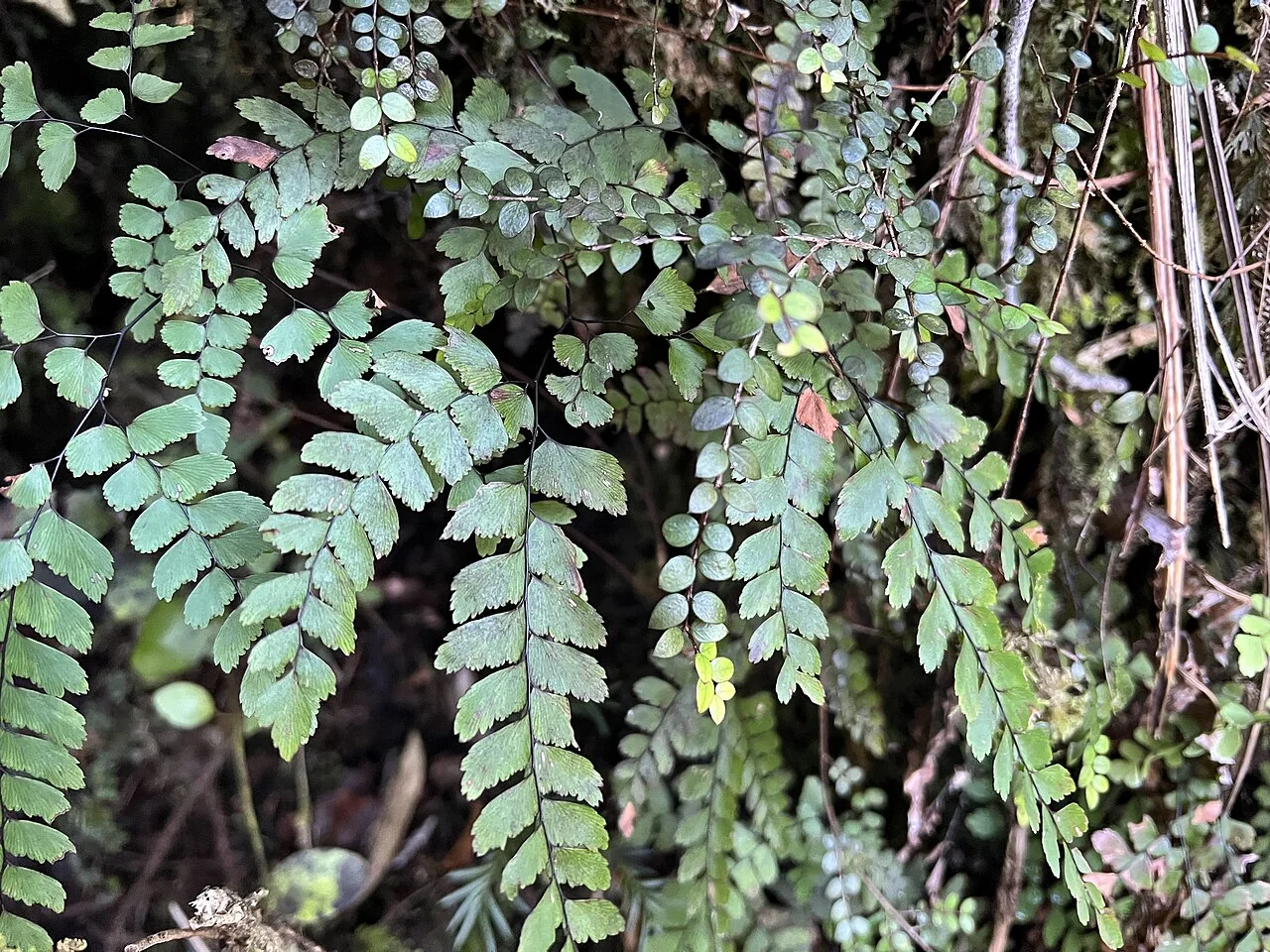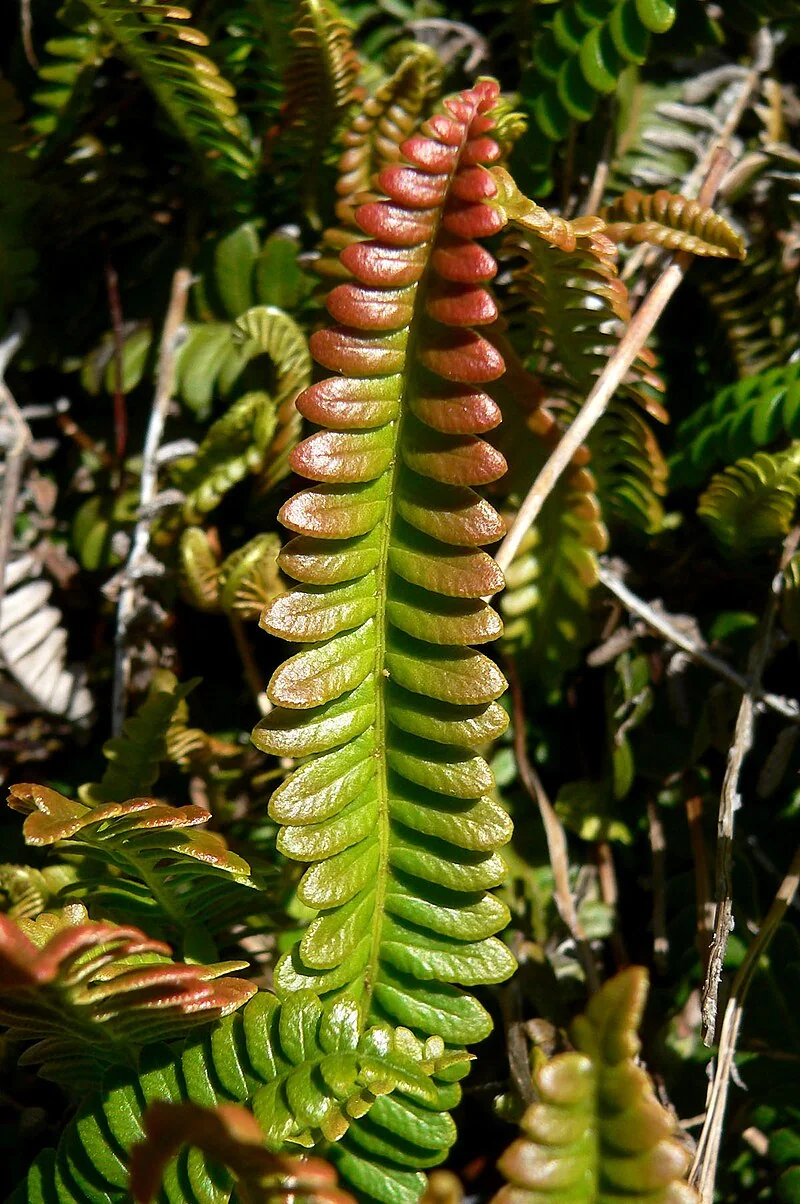
Cunningham's Maidenhair
Adiantum cunninghamii
Adiantum cunninghamii , commonly known as common maidenhair or Cunningham's maidenhair, is a graceful terrestrial fern endemic to New Zealand. It is found across the Kermadec Islands, Manawatāwhi / Three Kings Islands, North Island, South Island, Stewart Island/Rakiura, and Chatham Islands. This delicate fern is characterized by its tufted growth habit and short- to long-creeping rhizomes. Its fronds are dark green or glaucescent on the upper surface and paler, glaucous green, or blue-green underneath. The fronds are ovate to elliptic, ranging from 100-350 mm in length and 50-240 mm in width, and are typically 2-3-pinnate at the base, sometimes rarely 4-pinnate.

Plant Description
A finely textured maidenhair fern forming spreading colonies from slender, creeping rhizomes. Fronds 10-35 cm long, 2-3-pinnate with dark, wiry stipes and glossy, fan-shaped pinnules; undersides often glaucous. Sori protected by distinctive kidney-shaped indusia along the segment margins.
Quick Facts
| Common Names | Cunningham's Maidenhair Fern, Common Maidenhair |
|---|---|
| Scientific Name | Adiantum Cunninghamii |
| Family | Pteridaceae (Maidenhair fern family) |
| Growth Form | Terrestrial fern with creeping rhizomes |
| Height | 150-350mm tall |
| Spread | Creeping widely via rhizomes |
| Water Needs | High - consistent moisture required |
| Light | Deep to partial shade - no direct sun |
| Frost Tolerance | Moderate - protect from heavy frosts |
| Salt Tolerance | Low - inland forest species |
| Growth Rate | Slow initially, vigorous once established |
| Lifespan | Long-lived perennial with proper care |
| Distribution | Kermadec Islands, Manawatāwhi / Three Kings Islands, North Island, South Island, Stewart Island/Rakiura, Chatham Islands |
| Fronds | Dark green above, blue-green underneath; 100-350mm long, 2-3-pinnate |
| Distinctive Features | Kidney-shaped indusia, vigorous patch-forming habit |
| Habitat | Coastal and lowland forests, banks, cliff faces, amongst boulders |
| Elevation Range | Sea level to montane (occasionally upper montane) |
| Conservation Status | Not Threatened (as of 2023) |
| Etymology | Named after Allan Cunningham; Adiantum from Greek meaning "without moistened" (sheds water) |
Climate Best Suited to
Prefers cool to mild, humid conditions with even moisture and no direct sun. Best in coastal to lowland districts, thriving in sheltered gullies and shaded rock faces. Frost tolerance is moderate if soil remains moist and crowns are protected.
Regional Suitability
| City | Climate Suitability |
|---|---|
| Whangārei | Ideal |
| Auckland | Ideal |
| Hamilton | Ideal |
| Tauranga | Ideal |
| Rotorua | Ideal |
| Gisborne | Ideal |
| New Plymouth | Ideal |
| Napier | Ideal |
| Whanganui | Ideal |
| Palmerston North | Ideal |
| Wellington | Ideal |
| Nelson | Ideal |
| Christchurch | Ideal |
| Dunedin | Ideal |
| Invercargill | Ideal |
Natural Habitat
Shaded banks, boulder fields, limestone outcrops and damp forest margins from Kermadec and Three Kings south to Rakiura and Rēkohu/Chathams; elevations from sea level to montane.
Plant Conservation
Adiantum cunninghamii has a conservation status of "Not Threatened" according to the New Zealand Threat Classification System as of 2023. This classification reflects the species' stable populations and wide distribution across suitable habitats throughout New Zealand's forests.
The species demonstrates good resilience in its natural habitats, though like many forest understory species, it can be affected by habitat disturbance and the introduction of invasive plants. Conservation efforts focus on maintaining the integrity of native forest ecosystems where this fern thrives.
How to Grow
Planting Guide
Best Planting Practices
Plant divisions in spring into humus-rich media; mulch with leaf litter and keep evenly moist. Ideal for shaded rockeries, walls and fernery beds with limestone chips added where appropriate.
Ecological Role
Habitat Provider
In the wild, dense patches of Maidenhair fern stabilize steep banks and provide a humid microclimate for invertebrates and seedling regeneration of other forest plants.
Uses
Ornamental Value
One of the most popular native ferns for cultivation. Its elegant, arching fronds and bluish-green leaflets make it a stunning groundcover for shady, sheltered garden corners or under trees.
Landscaping Uses
Design Ideas
Mass plant under tree ferns for a classic New Zealand forest look. It also looks spectacular cascading over a shaded retaining wall or growing in a damp rockery.
Seasonal Care
Spring
Feed lightly and increase watering as new fronds flush.
Summer
Maintain humidity; never allow to dry out.
Autumn
Reduce feed; keep moisture even.
Winter
Protect from heavy frost; avoid cold, dry drafts indoors.
Pruning
Pruning Techniques
Remove spent or damaged fronds at the base to encourage fresh growth.
Rather than shearing the fern, groom little and often: snap out browned pinnules and entire fronds at the stipe to keep the clump tidy and reduce pest harbourage. Avoid cutting back hard in winter when new croziers are forming; light thinning improves airflow and helps prevent scale, mealybug, and fungal spotting in humid shade.
How to Grow Cunningham's Maidenhair
Cunningham's maidenhair thrives in bright, humid shade with evenly moist, free-draining, humus-rich soil. Choose a sheltered position that mimics its native forest banks and boulder crevices: cool root run, no midday sun, and good air movement without drying winds. In containers, use a peat-free fern mix amended with fine bark and pumice for porosity. Water little and often so the medium never dries; allow excess to drain freely. Feed lightly with a balanced, dilute liquid fertiliser during active growth. Indoors, group with other ferns or use a humidity tray to maintain frond quality. Outdoors, a thick mulch of leaf litter keeps rhizomes cool and evenly moist year-round.
Spores
To raise plants from spores, collect ripe, dark sporangia from healthy fronds. Tap onto clean paper, then sow the dust-fine spores over a freshly sterilised, fine fern medium. Seal the pot inside a clear container to maintain constant humidity and warmth (18-22°C) in bright, indirect light. A green film of prothalli appears first; when small fronds emerge, gradually vent to harden before pricking out. Use rainwater to avoid mineral spotting on the delicate pinnules. Spore culture is slow but yields many plants true to species.
Division
Established clumps can be divided in spring as croziers begin to push. Lift carefully, tease apart the creeping rhizomes, and replant sections with several vigorous growth points. Trim tired fronds to reduce transpiration, firm gently into fresh mix, water thoroughly, and keep in high humidity until new growth resumes. Site divisions in the original light level to prevent shock. Division is the fastest way to expand patches in the garden or refresh older container specimens.
After-Care
Maintain consistent moisture and humidity; never allow the crown to dry. Protect from slugs and snails, which can graze new croziers. Avoid heavy salts and hard water. If fronds brown at the tips, increase humidity, reduce direct light, and check watering frequency. Refresh surface mulch annually with leaf litter to mimic forest conditions and keep the root zone cool through summer.
Pests and Diseases
Common Problems and Solutions
Watch for scale and mealybug in dry air; slugs/snails may graze young fronds. Browning indicates low humidity or drought stress.
Cultural Significance
Traditional Uses and Values
Cunningham's Maidenhair Fern holds significance in New Zealand's botanical heritage. Named after Allan Cunningham, a prominent botanist and explorer who made significant contributions to understanding Australasian flora in the early 19th century, this species represents an important part of New Zealand's endemic fern diversity.
The genus name Adiantum comes from the Greek meaning "without moistened," referring to the fronds' ability to shed water - a characteristic that makes maidenhair ferns particularly distinctive. In traditional forest ecosystems, native ferns like this species play important ecological roles and are valued for their contribution to New Zealand's unique botanical character.
Bonus Tip
Expert Growing Advice
Use rainwater where possible-hard water can mark delicate frondlets.
Group pots together on a pebble tray to lift ambient humidity around the foliage, and site the plant out of air currents. A thin top‑dress of fine bark or leaf mould each spring recreates the cool forest litter this species favours and noticeably improves frond quality.







